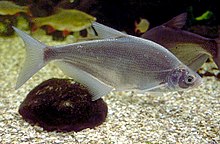Ballerus ballerus
| Ballerus ballerus | |
|---|---|

| |
| Scientific classification | |
| Domain: | Eukaryota |
| Kingdom: | Animalia |
| Phylum: | Chordata |
| Class: | Actinopterygii |
| Order: | Cypriniformes |
| Family: | Cyprinidae |
| Subfamily: | Leuciscinae |
| Genus: | Ballerus |
| Species: | B. ballerus
|
| Binomial name | |
| Ballerus ballerus | |
| Synonyms | |
| |
Ballerus ballerus, also known as the zope or the blue bream, is a species of cyprinid fish native to Eurasia.
Description
[edit]Ballerus ballerus is one of the more streamlined breams, with a more laterally compressed body (especially towards the tail) and an upturned mouth.[2] The eye is small[3] It has small scales and the lateral line consists of 67–75 scales. It is a pale silvery colour with either pale yellowish or colourless fins. They are normally 25–35 cm in length but occasionally can be up to 40 cm.[2] The maximum published weight is 940g,[3] although the largest rod caught fish, caught in Slovakia, weighed 2.2 kg and measured 53 cm in length.[4] The males develop nuptial tubercules above the anal fin during the spring spawning season.[1]
Distribution
[edit]Ballerus ballerus is found in the large lowland rivers draining to the Baltic Sea, although it is not found in northern Sweden and Finland north of 62°N; the Weser and Elbe draining into the North Sea; the Black Sea; the Don draining into the Sea of Azov; and the Volga and Ural which drain into the Caspian Sea, although it is rare in the Ural River. Its range spans from the Netherlands in the west to Russia and Georgia in the east.[1]
Habitat and ecology
[edit]Ballerus ballerus is occurs in large lowland rivers and eutrophic lakes[1] where it feeds on plankton which it catches close to the surface.[2] It spawns in Spring, once the ice has thawed, in shallow reedy bays onto the vegetation and the young fish stay in these areas although the adults move into open water to feed.[2] Spawning has been recorded on gravel in areas of moderate current.[1] This species lives for over 10 years and it breeds for the first time at 3–4 years when they have attained a standard length of 150mm. Spawning is initiated when the water temperature reaches 10 °C and usually lasts for only 1–2 weeks. The females spawn once a year while the males often defend spawning territories along the shoreline. It is known in some areas to migrate long distances to find suitable areas to spawn in. In some regions it will venture into the fresher parts of seas to find food.[1]
Zope software
[edit]The Python-based application server Zope is not named after this species; it is an acronym for "Z Object Published Environment". However, Zope3 was renamed "Bluebream", an alternative vernacular name for Ballerus ballerus.[5]
References
[edit]- ^ a b c d e f Freyhof, J. (2011). "Ballerus ballerus". IUCN Red List of Threatened Species. 2011: e.T135587A4153683. doi:10.2305/IUCN.UK.2008.RLTS.T135587A4153683.en. Retrieved 30 July 2023.
- ^ a b c d "Blue Bream Balleris ballerus". NatureGate. LuontoPortti. 2017. Retrieved 12 November 2017.
- ^ a b Rainer Froese; Daniel Pauly, eds. (2017). "Ballerus ballerus (Linnaeus, 1758) Zope". Fishbase. Retrieved 12 November 2017.
- ^ "Ballerus ballerus Zope, Blue Bream". Fishing World Records. Retrieved 12 November 2017.
- ^ "BlueBream v1.0b4 documentation". Zope Foundation. Archived from the original on January 22, 2010. Retrieved 12 November 2017.
- "Ballerus ballerus". Integrated Taxonomic Information System. Retrieved 24 January 2006.

